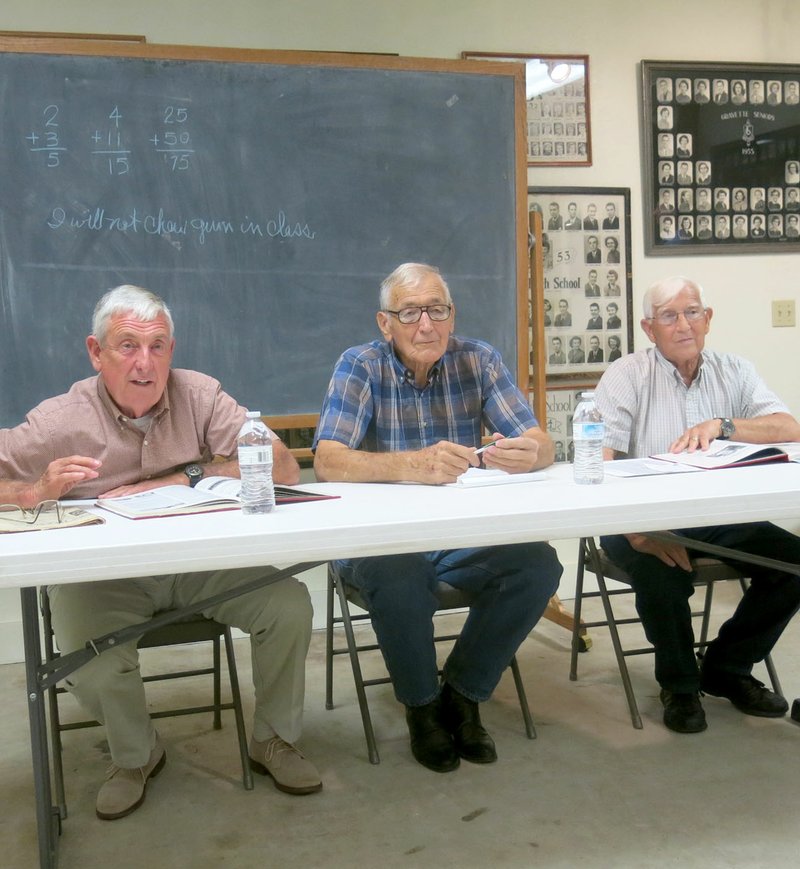GRAVETTE -- Gravette citizens Bob Kelley, John Mitchael and Dodie Evans presented a program on Gravette history Thursday, Aug. 26, in the Gravette museum annex. The program was cosponsored by the Gravette Historical Museum and the Gravette Public Library.
Dodie Evans spoke first and told about early Gravette history. The town has been around a short time, Evans said, but has a very rich history. The town began in 1893 when the Kansas City, Pittsburg and Gulf Railroad came into the area from Sulphur Springs. E.T. Gravett helped determine the route and laid out a town site, so the town was named for him. The first train ran through town in January, 1894.
Tracks were laid and the Arkansas and Oklahoma (A & O) Railroad came into town in late 1898 and connected with the K.C.P. , and G. Frisco purchased the line in 1900 and operated it many years. Many grapes, strawberries and apples were shipped from the area. Scenes for the movie "Jesse James," starring Tyrone Power and Henry Fonda, were filmed in 1938 along the track near Mt. Pleasant. The line was abandoned in 1940, but railroad elevations are still visible in several places in the area.
Bob Kelley related some of the history of Captain Field Kindley, America's fourth ranking air ace in World War I who lived with his uncle, A.E. Kindley, in Gravette as a youngster and attended Gravette schools. A.E. Kindley, along with E.T. Gravett, was one of the founders of the Bank of Gravett. Field Kindley joined the Kansas National Guard in 1917 and went on to Illinois for aviation training. He soon transferred to England where he logged more flying time with British squadrons and was commissioned a first lieutenant in the Signal Corps early in 1918.
In July, 1918, Kindley was assigned to the American 147th Aero Squadron. With his skill in flying, Kindley soon scored two kills in aerial combat and made a name for himself in the Air Service. By the end of October, 1918, he had recorded 12 official kills, establishing him as the nation's fourth ranking World War I ace. These exploits earned him the Distinguished Service Cross, the Bronze Oak Leaf and the British Flying Cross.
Captain Kindley was killed in an air accident February 1, 1920, when his plane crashed at Kelly Field in San Antonio, Texas. His funeral was the most elaborate ever seen in Gravette, with services held on the lawn of the Kindley home and mourners marching from there to the burial site at Hillcrest Cemetery north of town.
John Mitchael gave a history of the Gravette museum. Local barber Johnny Varner, with help from several townspeople, had created a diorama of Gravette in the 1920s. When Varner died, folks thought a museum should be created to house the model. The museum was started in one small room on First Avenue. At the end of the first year, enough artifacts had been collected to fill a second room. When the old Kindley home was offered for sale, the museum commission was able to buy it with help from the city and a generous loan from local businessmen Bill Meade and Ron Teasley.
Mitchael noted that the Butterfield Trail Chapter of Questers from Bella Vista has largely furnished the Kindley house with period antiques. They have recently purchased a rug and a coal-burning stove for the parlor.
In answer to a question from the audience, Evans told about several devastating fires the town has experienced, five before 1902. This led to the development of the town's first water supply. Significant improvements came to Gravette when Rolla Clinehans opened a drugstore and Dr. Billy V. Hall opened his practice on Main Street and later established a hospital. The Gravette Shelling Company was started by a Boston native who was traveling through town and stopped to visit a friend. He saw a need and started a business to fill it. Employees of the company designed and built machines to crack, dry and separate the nuts.
"These were all people with big ideas who made big things happen," Evans said. "We have a history of that in Gravette. Their hard work and initiative are the secret of making things happen."
Mitchael reminisced about Gravette being a town where people didn't go out of town for shopping, where children were safe at night and residents were caring people. He said the museum had recently acquired the school board minutes from 1914 through 1948, including the resume from long-time school superintendent Glenn Duffy. Mitchael recalled that he graduated in April, 1941, and the doors were locked the following Monday because the school stopped receiving state money. He said that in 1955 or 1956 Duffy took out a personal loan to buy equipment for the six-man football team.
An audience member noted that the school still attracts good teachers and mentioned in particular the late Angela Scott who was sponsor of a health occupations student organization that has produced 111 doctors, nurses and a a pharmacy tech.
Evans told a little about the Bank of Gravett, the oldest bank in Benton County, and noted it survived the depression when all others in the area failed. In answer to a question from the audience, Louise Evans said the Methodist Church was the oldest congregation in town but it is now in its second building. The oldest church building in Gravette is the Christian Church, built in 1898. The Presbyterian Church was built later that year.
The speakers concluded their program by saying that Gravette today is a town with good community leaders and a good school system. It is a good faith-based community with many churches, they said, and good civic organizations.
General News on 09/07/2016
